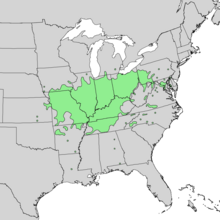Quercus imbricaria
| Shingle Oak | |
|---|---|

| |
| Scientific classification | |
| Kingdom: | |
| (unranked): | |
| (unranked): | |
| (unranked): | |
| Order: | |
| Family: | |
| Genus: | |
| Section: | |
| Species: | Q. imbricaria
|
| Binomial name | |
| Quercus imbricaria | |

| |
| Natural range | |
Quercus imbricaria, the shingle oak, is a deciduous tree in the red oak group of oaks. It is native primarily to the Midwestern and Upper South regions of North America, from southern New York west to northern Illinois and eastern Kansas, and south to central Alabama and Arkansas. It is most commonly found growing in uplands with good drainage, less often along lowland streams, at 100-700 m altitude.
It is a medium-sized tree growing to 20 m tall, with a trunk up to 1 m diameter (rarely 1.4 m). It is distinguished from most other oaks by its leaves, which are shaped like laurel leaves, 8-20 cm long and 1.5-7.5 cm broad with an entire margin; they are bright green above, paler and somewhat downy beneath. The fruit is an acorn, 9-18 mm long and wide with a shallow cup; they are mature about 18 months after pollination. They are an important food for squirrels and some birds.
Description

A tree usually fifty to sixty feet high, maximum height one hundred, with broad pyramidal head when young, becoming in old age broad-topped and open. Rare in the east, abundant in the lower Ohio Valley and middle Mississippi Valley. It reaches its largest size in southern Illinois and Indiana, although the national champion is 104' by 68' in Cincinnati, OH.
- Bark: Light brown, scaly; on young stems light brown, smooth. Branchlets slender, dark green and shining at first, later become light brown, finally dark brown.
- Wood: Pale reddish brown, sapwood lighter; heavy, hard coarse-grained, checks badly in drying; used for shingles and sometimes in construction. Sp. gr., 0.7529; weight of cu. ft., 46.92 lbs.
- Winter buds: Light brown, ovate, acute, one-eight inch long.
- Leaves: Alternate, oblong or obovate, four to six inches long, one to two inches wide, wedge-shaped or rounded at base, acute or rounded at apex, sometimes entire or with undulated margins, sometimes more or less three-lobed. They come out of the bud involute, bright red, covered with rusty down above and white tomentum below. When full grown are dark green, smooth and shining above, pale green or pale brown, downy below; midribs stout yellow, grooved above, primary veins slender. In autumn they become dark red above, pale beneath, midribs darken, then the leaf. Petioles stout, hairy, flattened, grooved. Stipules about one-half inch long, caducous.
- Flowers: May, when leaves are half grown. Staminate flowers borne on tomentose aments two to three inches long. Bracts linear-lanceoate. Calyx pale yellow, downy, four-lobed; stamens four to five; anthers yellow. Pistillate flowers borne on slender tomentose peduncles. Involucres scales are downy, about as long as the calyx lobes; stigmas short, reflexed, greenish-yellow.
- Acorns: Ripen in autumn of second year; stalked, solitary or in pairs; nut almost spherical, one-half to two-thirds inch long; cup embraces one-half to two-thirds nut, is cup-shaped covered with light red brown, downy scales, rounded or acute at apex. Kernel very bitter.[1]
Cultivation and uses
In the past, the wood was important for making shingles, from which the name derives.
Hybrids
- Q. × leana Nutt. (Q. velutina x Q. imbricaria) (Lea's hybrid oak), a naturally occurring hybrid of the black oak and shingle oak, growing to 20 m, a native of south-eastern North America, also found in a few European collections.
References
- ^ Keeler, Harriet L. (1900). Our Native Trees and How to Identify Them. New York: Charles Scriber's Sons. pp. 372–374.
